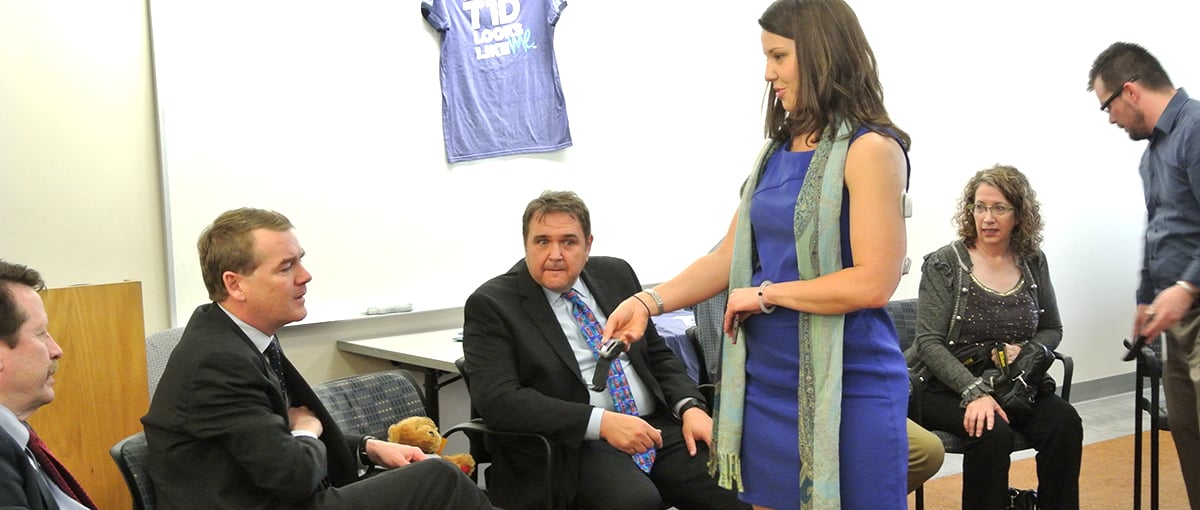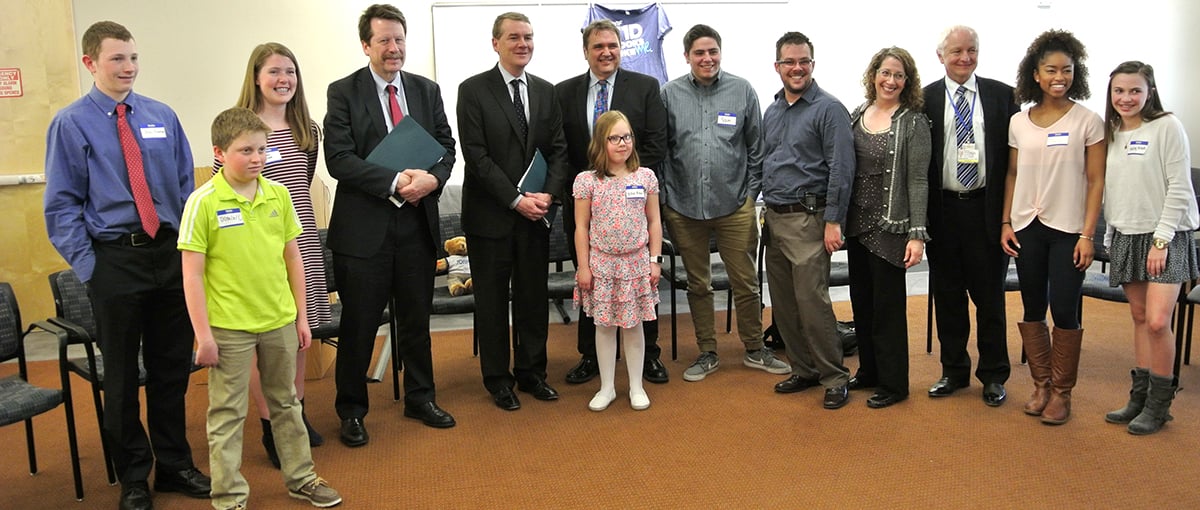The days of constantly checking his blood-sugar levels are over for Jason Gensler, who has type 1 diabetes. Now that he wears a state-of-the-art artificial pancreas that automatically monitors and adjusts his levels, a huge burden has been lifted.
 Kelli Raleigh, outreach manager for the JDRF Foundation, displays her continuous glucose monitor to Sen. Michael Bennet (second from left) during the senator's visit. At far left is Robert Califf, MD, commissioner of the Food and Drug Administration, and in the center is Robert Garelick, executive director of JDRF's Rocky Mountain chapter. Jason Gensler, who wears a state-of-the-art artificial pancreas, is pictured at far right.
Kelli Raleigh, outreach manager for the JDRF Foundation, displays her continuous glucose monitor to Sen. Michael Bennet (second from left) during the senator's visit. At far left is Robert Califf, MD, commissioner of the Food and Drug Administration, and in the center is Robert Garelick, executive director of JDRF's Rocky Mountain chapter. Jason Gensler, who wears a state-of-the-art artificial pancreas, is pictured at far right.
“It keeps you in your target range all the time – it’s incredible,” said Gensler, a professional research assistant at the Barbara Davis Center for Diabetes. “With this, you can relinquish control, and you have so much more time to do whatever you want. The relief of that stress and burden is obviously the thing I’m most grateful for.”
A room of grateful and optimistic people greeted Sen. Michael Bennet (D) and Robert Califf, MD, commissioner of the Food and Drug Administration (FDA), when they visited the Barbara Davis Center at the CU Anschutz Medical Campus on April 1. They also attended a roundtable discussion with members of the Colorado Bioscience Association and CU Anschutz faculty members.
Bennet convened the gathering as part of his years-long effort to highlight the importance of an FDA-approved artificial pancreas (AP) system. The senator invited Califf to CU Anschutz to hear directly from these families about the life-changing effects of this technology and compel Califf to prioritize the final stages of the AP.
Bennet and Califf were joined by David Maahs, MD, PhD, associate professor of pediatrics, and Marian Rewers, MD, PhD, professor of pediatrics and executive director of the Barbara Davis Center.
'World-class facility'
Seven families who are affected by type 1 diabetes talked about their experiences with new devices, such as continuous glucose monitors (CGM), which when combined with an insulin pump and a computer program constitute an AP. They also expressed hopes for a cure to the disease that adds 1.4 million cases every year in the United States.
 Patients with type 1 diabetes are pictured with FDA Commissioner Robert Califf, MD, (fourth from left), Sen. Michael Bennet (fifth from left) and Robert Garelick, executive director of JDRF Rocky Mountain chapter (sixth from left) during Califf and Bennet's visit to the Barbara Davis Center for Diabetes on April 1. Marian Rewers, MD, PhD, executive director of the Barbara Davis Center, is pictured third from right.
Patients with type 1 diabetes are pictured with FDA Commissioner Robert Califf, MD, (fourth from left), Sen. Michael Bennet (fifth from left) and Robert Garelick, executive director of JDRF Rocky Mountain chapter (sixth from left) during Califf and Bennet's visit to the Barbara Davis Center for Diabetes on April 1. Marian Rewers, MD, PhD, executive director of the Barbara Davis Center, is pictured third from right.
“The Barbara Davis Center is a world-class facility that helps people of any age who are diagnosed with type 1 diabetes,” said Bob Pailet, whose 23-year-old daughter, Molly, was diagnosed six years ago. Pailet, sitting with his wife, Cindy, added, “We’ll be thrilled when Molly is cured someday, but, in addition, America spends many billions of dollars a year in health care costs related to type 1 diabetes. So, from a citizenship standpoint, we’d like to see that burden go away, too.”
Bennet and Califf praised the families for participating in research at the Barbara Davis Center, which is funded primarily through grants from the National Institutes of Health (NIH) and the JDRF Diabetes Foundation. JDFR, launched by parents of children with type 1 diabetes and run mostly by volunteers, has funded $2 billion of type 1 diabetes research worldwide, including at the Barbara Davis Center, since its founding.
Califf said progress toward successful interventions, prevention and a potential cure is made possible when type 1 diabetes families participate in studies. “You are all pioneers for a whole bunch of people who are going to come along behind you and benefit from the work you are doing,” he said.
Maahs is involved in multiple studies taking place at the Barbara Davis Center. Devices such as the artificial pancreas worn by Gensler – a model that the manufacturer anticipates will receive FDA approval and enter the market in spring 2017 – will continue to develop over time and give people with type 1 diabetes more choices. “The technology is going to go in a step-like fashion, and we’re probably going to be working on refining these over the next couple decades,” he said.
'They're going to help patients'
 Tiana Cooks (third from left) explains how type 1 diabetes has made her a stronger person, during the visit by Sen. Michael Bennet and FDA Commissioner Robert Califf, MD. Cooks said, "I had to figure out that God has another plan for me ... I've just really had to take a positive view of my life."
Tiana Cooks (third from left) explains how type 1 diabetes has made her a stronger person, during the visit by Sen. Michael Bennet and FDA Commissioner Robert Califf, MD. Cooks said, "I had to figure out that God has another plan for me ... I've just really had to take a positive view of my life."
The researchers and JDRF officials greatly appreciated the visit by the FDA commissioner and Bennet, as Congress is instrumental to NIH funding. In 2012, Bennet convened a similar meeting to highlight the lack of options available for kids with diabetes. The gathering helped prompt the FDA to release guidance so researchers and companies could determine how to develop an AP system. Four years later, some of the same families explained the significance of the progress so far, and the exponential effects a full AP system can have on their lives.
The FDA is vital in the process of getting new, patient-aiding devices approved, Maahs said. “They play an important role in terms of safety, and they’re very collaborative with industry – we all work together,” he said. “It’s very clear, with these types of research studies, how they’re going to help patients.”
Type 1 diabetes cases are dramatically increasing – another aspect that is being studied. Rewers said the number of people diagnosed with the disease doubles every 20 years. The good news is, he said, thanks to new treatments and the way the disease is managed, their life expectancy is the same as people without type 1 diabetes.
